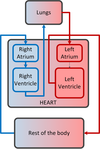Chapter 11-Transport in Animals Flashcards
List the different parts in the heart.

- A-Aorta
- B-Pulmonary Artery
- C-Pulmonary Vein
- D-Left Atrium
- E-Bicuspid Valves
- F-Left Ventricle
- G-Inferior Vena Cava
- H-Right Ventricle
- I-Tricuspid Valves
- J-Right Atrium
- K-Superior Vena Cava
Unlisted: the divider between the right chambers and left chambers is the septum.

Why is the heart described as a double pump?
Blood travels in the heart twice before travelling to the rest of the body.
List and describe the 2 types of circulation.
- Pulmonary: Deoxygenated blood from the body, to the heart, to the lungs to get oxygenated.
- Systemic: Oxygenated from the lung to the heart to all the body systems.

Describe:
Pulmonary Circulation
- Is through the lungs
- O2 blood is carried in the pulmonary veins to the heart
- CO2 blood is carried in the pulmonary artery from the heart to the lungs.
- Pulmonary is weaker with less pressure
Describe:
Systemic Circulation
- Through the whole body.
- O2 blood is carried in the aorta from the heart to the body.
- CO2 blood is carried in the vena cava to the heart from the rest of the body.
- Pulmonary circulation is stronger with higher pressure.
How does the heart pump blood?
The heart pumps blood by the walls contracting and relaxing.
What is diastole and what is systole.
- Diastole are relaxations in the heart
- Systole are contractions in the heart
Describe the cardiac cycle.
- Both atria contract and force blood into the ventricle (atrial systole)
- Ventricles contract and they pump blood into the pulmonary artery and aorta (ventricular systole)
- The whole heart relaxes and blood flows into the atria again (general diastole)
List the different components of the blood and their functions.
- Red Blood Cell: To transport Oxygen around the vody.
- White Blood Cell: Defend the body against diseases.
- Plateletes: To clot blood.
- Plasma: Transport cells, food, nutrients and gases and waste material like CO2 , Uric Acid and Urea.
Describe the features of Red Blood Cells.
- Live for 120 days.
- Biconcave shape: Makes them flexible to fit into smallest capillary.
- Have no nucleus increase surface area to carry O2
- Thin membrane, easy diffusion of O2 into and out.
- Has haemoglobin which combine with O2 to form oxyhaemoglobin.
- Shortage of haemoglobin is caused by iron deficiency-leads to anemia.
- Symptoms: Pale skin, extreme fatigue
Describe the features of White Blood Cells.
- Two types: lymphocytes and phagocytes
- Life span of 20 days.
- Can change shape and squeeze through the gaps between cells.
- Have nucleus to carry out instructions, can also divide.
- Phagocytes: Have a lobed nucleus, can engulf nd destroy harmful pathogens like bacteria.
- Lymphocytes: Have very large nucleus, produce anti-bodies against harmful pathogens.
- Anti-bodies have antigens (specific shape) which look into pathogen and destroy it/
Describe the functions of plateletes.
- Are tiny fragments of red blood cells.
- Assist in clotting wounds.
- Produce clotting factor VIII that helps to change soluble fibronogen into insoluble fibrin threads. This forms a network over the wound and Red Blood Cells, Plateletes and White Blood Cells collect at the site with fibrin threads to form the clot.
- Calcium is needed for this process.
Define:
Immunity
The protection and defence against the pathogens (foreign pathogens) and infection. The ability for an organism to resist infection.
List some of the ways in which the body protects us.
- Acid in our stomach
- Our skin is a barrier (and waterproof)
- Acid in our urethra (from urine.)
- Mucus in the lining of women’s vaginas
- Mucus in our trachea
- White Blood Cells
List the different types of natural immunity and accquired immunity.
- Natural Immunity: Physical barriers i.e. skin, saliva, stomach acid, mucus membrane. And your own phagocyte and lymphocytes and antibodies. Vaccine.
- Accquired Immunity: Breast milk from mum (colustrum). Blood transfusion.



